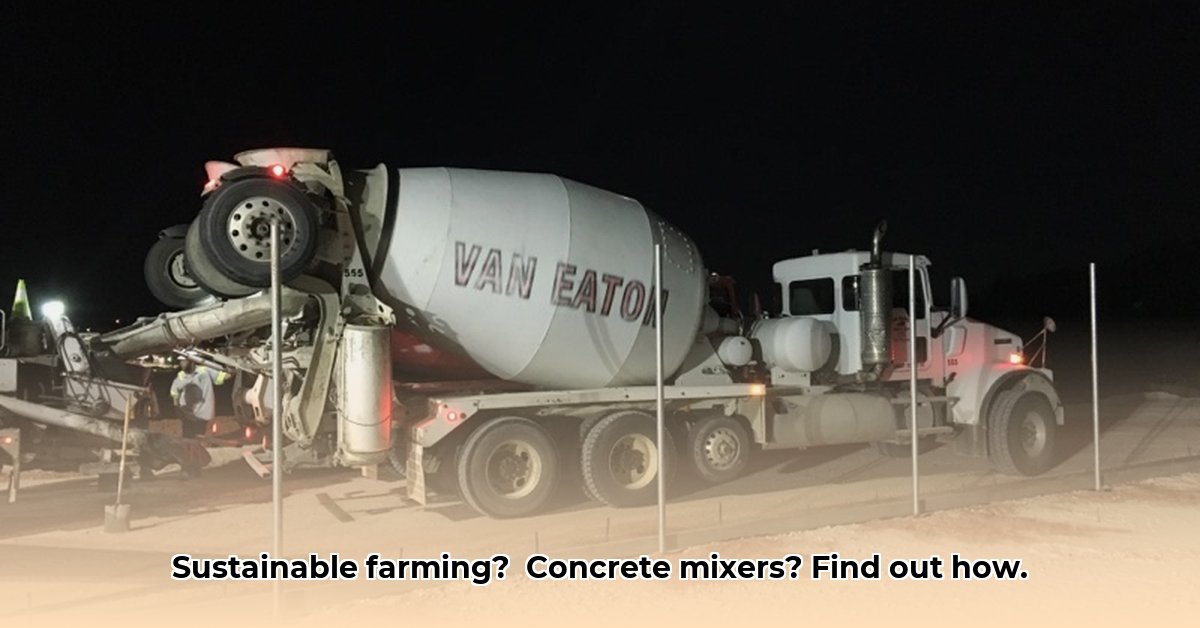
Concrete Mixer Tractor Supply: Building a Greener Future in Agriculture
Sustainable agriculture demands responsible infrastructure choices. Concrete, while essential for durable structures like silos and barns, carries a significant environmental footprint due to its embodied carbon (the greenhouse gases released during its production). However, innovative solutions and sustainable practices can mitigate this impact. This article explores how to leverage concrete responsibly in farming, focusing on the efficiency and environmental benefits of on-site mixing using portable concrete mixers, such as those available from Tractor Supply Co. For more information on choosing the right mixer, check out Tractor Supply Mixers.
The Environmental Impact of Concrete: Finding the Right Balance
Concrete's strength and durability make it ideal for farm structures. Yet, its production is energy-intensive and releases substantial greenhouse gases. This embodied carbon contributes to climate change—a concerning reality for environmentally conscious farmers. However, the landscape is changing.
Supplementary Cementitious Materials (SCMs) (materials added to regular concrete mixes to reduce the amount of cement needed), like fly ash (a byproduct of coal combustion) and slag (a byproduct of steelmaking), are game-changers. These materials significantly reduce the cement needed, lowering the carbon footprint of concrete. Ongoing research into even more effective SCMs and alternative cementing agents promises further improvements. This is vital for balancing the requirement for robust farm infrastructure with environmental preservation.
Concrete Mixers from Tractor Supply Co.: On-Site Efficiency and Environmental Benefits
Portable concrete mixers, readily available from retailers like Tractor Supply Co., offer a practical approach to sustainable construction. Mixing concrete on-site significantly reduces transportation needs, leading to lower fuel consumption and associated emissions. This affects not only constructing new silos or barns but also smaller projects like repairing irrigation systems. The reduced transportation footprint directly translates to lower greenhouse gas emissions—a crucial benefit for environmentally conscious farmers.
Isn't it interesting that such a simple change can make a significant environmental impact? Many farmers are already finding that on-site mixing also reduces material waste, leading to cost savings and reduced landfill burden.
Minimizing Your Environmental Footprint: Practical Steps for Greener Building
Here are actionable steps to minimize the environmental impact of your concrete projects:
Source Low-Carbon Concrete or Utilize SCMs: Inquire about low-carbon concrete options from your suppliers. Look for concrete mixes incorporating SCMs (Supplementary Cementitious Materials), which utilize industrial byproducts to reduce the need for traditional cement, resulting in a lower carbon footprint.
Precise Planning Prevents Waste: Accurately estimate concrete needs before ordering to minimize waste and its subsequent landfill impact. Careful planning can save you both money and reduce environmental burden.
Responsible Building Practices: Employ efficient techniques during construction to minimize material loss and water waste, thereby maximizing resource efficiency.
Correct Disposal Procedures: Dispose of excess concrete responsibly. Research local recycling options or designated facilities for proper disposal.
Explore Alternative Materials: For suitable projects, consider sustainable alternatives such as recycled materials, timber, or other eco-friendly options, reducing your reliance on concrete altogether.
Future Trends: Innovation in Sustainable Concrete
The future of sustainable concrete looks bright. Researchers are developing carbon capture and utilization technologies, aiming to recapture CO2 emissions during concrete production and even integrate it into the concrete mix itself. This could revolutionize the industry's environmental profile. Innovations in alternative binding agents are also showing promise, potentially replacing traditional cement with significantly lower-impact alternatives.
Sustainable Concrete: A Summary Table
| Strategy | Short-Term Benefits | Long-Term Benefits | Potential Challenges |
|---|---|---|---|
| Low-carbon concrete | Reduced immediate greenhouse gas emissions | Lower overall life-cycle carbon footprint | Potential higher initial cost; regional availability may vary |
| On-site mixing | Reduced fuel consumption and transportation emissions | Improved project efficiency and cost savings | Requires investment in portable mixing equipment |
| Waste minimization | Cost savings from less material use | Reduced landfill waste and environmental impact | Requires careful planning and accurate estimations |
| Alternative material use | Reduced reliance on concrete | Diversification of building materials and potentially lower embodied carbon | May require changes in design and construction practices; material availability may vary |
By embracing these strategies, farmers can create a strong, sustainable infrastructure while minimizing their environmental footprint, contributing to a greener future for agriculture. The decision to use a portable mixer is a simple yet powerful step in this direction.